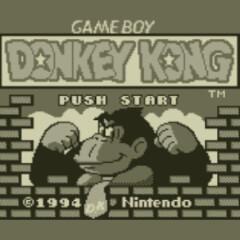
Question: when did the first game in the Mario vs. Donkey Kong series come out? If you said 2004, you'd be right. Sort of. Mario vs. Donkey Kong was first shown at E3 2002 as Donkey Kong Plus and is the spiritual successor to the Game Boy version of Donkey Kong, often referred to as Donkey Kong '94.
Donkey Kong was already incredibly popular because of the timeless arcade game which had been released a number of years earlier, so Donkey Kong '94 was Nintendo's opportunity to play with the formula. The game still starts with the familiar 25m, 50m, 75m and 100m levels, but it's after those that things start to get really interesting.
After supposedly finishing off Donkey Kong at 100m, the troublesome ape once again kidnaps Pauline and runs off, laying traps and puzzles to try and prevent Mario from moving any further. This is where the game takes an unexpected turn, as Mario now has to travel through a number of different worlds to get to Donkey Kong and save Pauline. These aren't your run-of-the-mill Super Mario Bros. worlds, though: each level is unique and every one is a puzzle more difficult than the last.
On each level - of which there are 100 in the entire game - there are two objectives players have to clear. The 'end' of each level is a locked door, and each level also holds the key to that door. You will first have to collect the key, then you have to carry it to the door. There are a number of obstacles in every level trying to prevent you from doing that, including ladders, conveyor belts, spikes, flames and, of course, numerous enemies trying to get in your way.
There are ten stages in the game, ranging from the Construction Site where you start off to more varied settings such as a ship, a jungle and even an iceberg. Each of these has its own dangers, such as vines in the jungle and slippery floors on the iceberg, which will pose even more problems as you move on in the game. Every fourth level also sees you try to save Pauline, with the last level of each stage pitting you against Donkey Kong himself, after which he'll take her away again and you'll move onto the next stage.
In each level, there are also three items which you can choose to collect - a hat, a bag and a parasol. Collecting these items will result in a bonus game in which you can collect a number of extra lives depending on the game. In one game, for example, you can earn one, two or three extra lives, whereas in another, you can earn up to five, but could potentially earn none.
You will also earn additional lives after every fourth stage. When you complete a level, the number of seconds left on the timer is saved - these are added together and, after each fourth stage, your last four times are added together to give you a total. You'll receive an extra life for every 100 seconds in the total and another for the remainder (so for example, for anywhere between 301 and 400 seconds left on the clock, you'd get four additional lives).
The game is certainly very easy to control, regardless of whether you're using the Circle Pad or the D-Pad to move Mario. Of course, Mario is able to jump, but with good timing you'll also be able to perform much better moves such as handstands and backflips, which will allow Mario to get to even higher places without having to jump between platforms. A good sense of timing is vital throughout, as many enemies and obstacles can very quickly get in Mario's way.
A number of Game Boy games (and by extension, most classic or retro games) are known to be quite difficult and don't often give the player much help, but Donkey Kong finds the perfect balance: after every fourth level, it runs a preview of upcoming levels, whether showing the introduction of a new item or enemy or giving hints as to which of Mario's moves is going to be of help. Even so, the levels become increasingly difficult and frustrating, to the point where it may take a considerable number of attempts to get past just one.
This is where the Nintendo 3DS Virtual Console menu can come in handy for the more uncertain players: the game will give you the option to save after every fourth level, but using the Restore Point feature, you can theoretically 'save' whenever you please. While this does make the game a little easier - stockpiling lives can really pay off come the last couple of stages - it certainly doesn't detract from the value or fun to be had from the gameplay.
Donkey Kong is an incredible game. It shows us just why the Virtual Console is so great: it can pull hidden gems up from years and years ago and give them to a brand new audience. There have been a number of great games made available for the Nintendo 3DS Virtual Console so far, but Donkey Kong is by far the most deserving of that new audience. For Mario fans - and particularly fans of the Mario vs. Donkey Kong series - this is a must-buy. For everyone else, given the price, it's bound to be worth a try - and who knows, you might just find your new favourite game.



 SUPPORT US ON KO-FI!
SUPPORT US ON KO-FI!